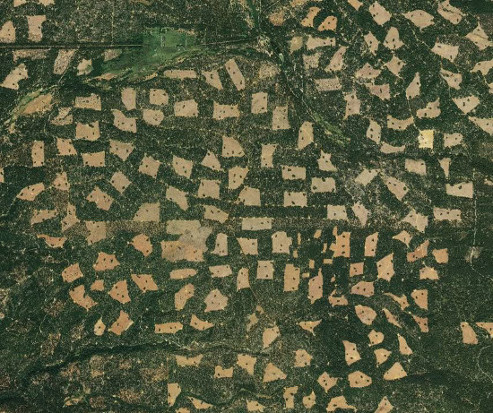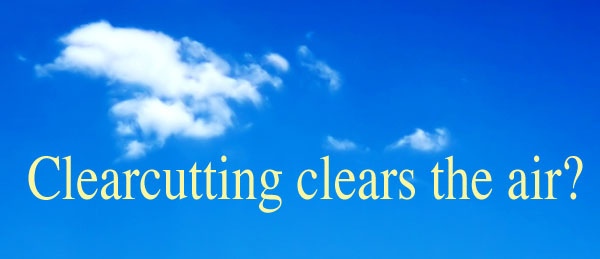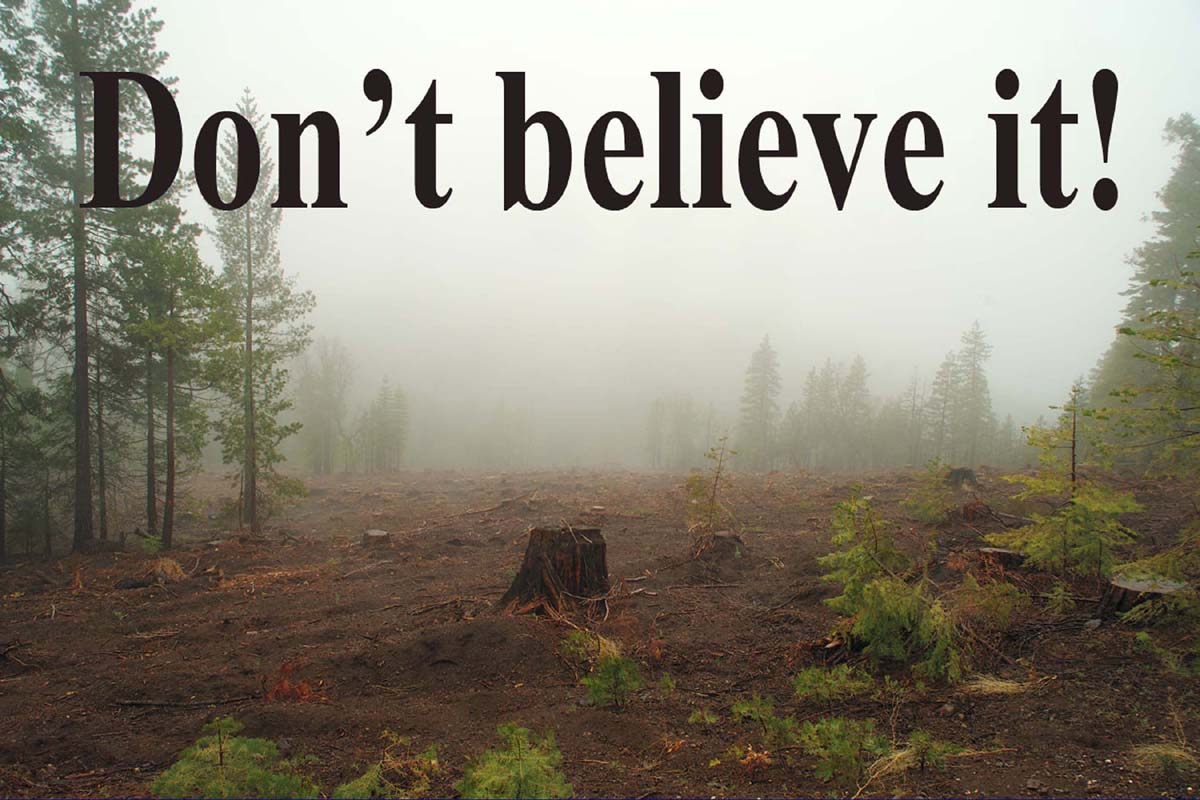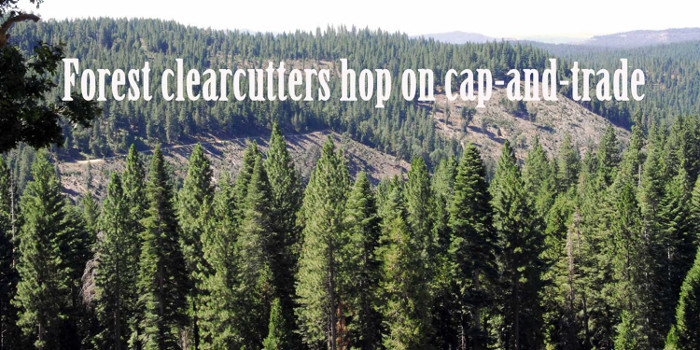With a rising tone of urgency, a cadre of environmental organizations including Forests Forever is demanding that the California Air Resources Board (ARB) reverse its recent approval of a cap-and-trade protocol that will allow – and even encourage – forest landowners to make windfall profits by registering forest offset projects that may include clearcuts of up to 40 acres each.
We’ll
explain the meaning of “offsets” as we go. For the
moment, please realize it’s a bit of jargon that forest
defenders only recently have had to come to terms with.
The
cap-and-trade system we refer to is the one being set up by
the ARB as part of A.B. 32, the Global Warming Solutions Act
of 2006. Other cap-and-trade systems are being set up regionally
and internationally (although various proposals for a national
system have been stymied in Congress) and linked in various
ways, but for the sake of focusing on California, we’ll
leave those aside.
With the ARB’s approval last December of a protocol
for forest offset projects under cap-and-trade, landowners may
lay claim to “offsetting” other industries’
greenhouse-gas (GHG) pollution, even as said landowners are
allowed to clearcut parcels of up to 40 acres. This they can
do regardless of whether their clearcuts occur inside or outside
of their project areas. Either way, ARB may still credit the
landowners for conducting “sustainable” forestry
practices on their lands.
Once
registered with the ARB and credited with reducing GHG emissions,
these landowners or timber companies can then take part in the
lucrative trading of carbon pollution offsets in the cap-and-trade
marketplace.
In that arena, industries required by
ARB to reduce their GHG emissions engage in the trading of both
“offsets” and “allowances.” The two
terms represent distinct instruments of the cap-and-trade marketplace
– not unlike stocks and bonds in financial markets. But
rather than representing wealth, the instruments represent attempts
to reduce GHG emissions – a crucial step in halting global
warming. The terms have important distinctions, which we’ll
come to later. For now, let’s focus on offsets.
A free pass on CO2 emissions
Under
the Byzantine forest protocol just adopted by ARB, a timberland
owner could cherry-pick which project-area parcels to register
for the offsets portion of the cap-and-trade market. At the
same time that owner could shift destructive logging practices
– including clearcutting – to lands outside the
project-area boundaries. Business as usual, including clearcutting,
could go largely unchecked on the ownership.
This practice, referred to in the field of cap-and-trade policy
as “leakage,” distorts GHG accounting and defeats
efforts to control emissions. Yet to the detriment of the program,
ARB does little to discourage and nothing to police such leakage
in the forest sector.
It gets worse. The ARB, lacking any sound scientific justification,
overlooks the possibility that individual timber companies –
especially those doing clearcutting – may be net emitters
of CO2 from their forestlands. (More about that later on.) Instead,
the ARB considers the forest sector categorically, as a whole,
to be a net carbon sink, always sequestering more CO2 than it
releases, regardless of what kind of forestry is going on.
Extending this reasoning even further, because timber is categorically
deemed a green industry, never a polluter, participation of
forest landowners in the cap-and-trade program is purely voluntary.
The whole reason clearcutting became an issue in the forest
protocol debate, said Brian Nowicki, California Climate Policy
Director at the Center for Biological Diversity (CBD), is that
the forest sector is the only economic sector deemed by the
ARB to sequester more CO2 than it releases, making it a principal
potential source of offsets for the cap-and-trade market.
In making this assertion, ARB relies on California’s purportedly
“stringent” forestry laws while rejecting the possibility
that a lawful logging operation might be a net emitter of CO2.
Thus, decrees ARB, timberland owners practicing clearcutting
get a free pass on CO2 emissions restrictions while earning
easy money by selling offsets in the cap-and-trade market.
The devil is in the details
At this point, dear reader, if your eyes are
starting to glaze over at the complexity of this offsets scheme,
we understand. As environmental educator and “The
Story of Stuff” creator Annie Leonard says in her
trenchant YouTube
video on cap-and-trade, “the devils are in the details.”
The more complex schemes such as forest offsets become, the
greater the likelihood of them being gamed, loop-holed, hornswoggled
or otherwise tampered with by industry. Which is exactly what’s
happening here.
With that in mind, bear with us as we delve deeper into the
details, attempting to cleanly sort them out for you.
To participate in the offsets program, forestland owners must
meet certain criteria. The ARB requires them to employ and demonstrate
long-term “sustainable” harvesting practices on
all of their forest landholdings, both inside and outside any
given project areas.
(Project areas need be of no set size; their dimensions may
vary greatly. The project area boundary must circumscribe all
GHG sinks, reservoirs and emission sources – such as retained
forests, tree cutting and replanting, site preparation, debris
burning and the like – that must be accounted for during
the offset project’s duration.)
Forest owners may demonstrate “sustainability” in
any one of three ways.
First, they may submit to third-party certification of their
management practices under the Forest Stewardship Council (which
is well regarded by most environmental groups), the industry’s
Sustainable Forestry Initiative greenwash, or the American Tree
Farm System, another forest-industry sponsored program.
Second, they may adhere to a renewable long-term management
plan that demonstrates “sustainable” harvest levels
over time and is sanctioned and monitored by a state or federal
agency.
These two options do not preclude clearcutting occurring on
an ownership, but do require certain concessions by the forest
owner. On a watershed of up to 10,000 acres, operations within
project areas must maintain, or make progress toward maintaining,
at least 60 percent of their acreage in forests at least 20
years old.
In an attempt to assure that decreased harvesting inside a project
area does not simply lead to increased harvesting outside the
project area (an abuse known as “leakage”), the
forest owner must meet the “sustainability” criteria
on all of its landholdings.
Last but not least, forest owners may demonstrate “sustainability”
by employing only uneven-aged harvesting (i.e. no clearcuts)
in a given project area, while maintaining a canopy cover averaging
at least 40 percent across all of their holdings in and around
the project area.
Let’s hope this is all starting to make sense.
Baselines, assessment areas, additionality and more
In
all of the scenarios just mentioned, for monitoring purposes,
setting baselines and boundaries is key.
By the time of a project’s onset the ARB is supposed to
have determined the historic biomass and carbon-storage levels
for the project area.
This calculation is done using statistically representative
“assessment areas,” which may vary in size and are
supposed to typify the forest communities in and around the
project area. The assessment areas may or may not overlap the
project areas.
A project area can extend across multiple assessment areas.
Assessment areas themselves fall within geographically identified
“ecosections,” which are large administrative areas
governing forest management. These in turn may be combined to
form “supersections.”
Throughout the course of a given project – which may last
up to 100 years – the baseline serves to calculate the
progress (or failure) of the project in storing CO2 above the
baseline.
The ARB justifies clearcutting being allowed to occur on “sustainable”
holdings on the grounds that the practice is already allowed
under state forestry law, and that, as ARB Public Affairs Spokesperson
Stanley Young told Forests Forever, “California’s
Forest Practice Rules are the most stringent in the nation.”
But the rule granting forest offset projects permission to incorporate
clearcuts, and for clearcutting timberland owners generally
to qualify to sell offsets, has prompted environmental groups
to cry foul – in particular, CBD, Sierra Club California,
Ebbetts Pass Forest Watch and Forests Forever. Clearcutting
is notorious for its harmful effects on water quality, wildlife
habitat, microclimates, and for increased global warming emissions.
“What we’re asking for specifically is that projects
being registered as part of the carbon offset program not be
allowed to include clearcutting,” said Nowicki. “More
specifically we wouldn’t have existing native forests
converted into tree farms via clearcutting.
“We’d like to see the carbon offset program serve
as an incentive to increase the conservation of standing forests
because that’s not only one of their most valuable benefits
as far as their ability to absorb and store carbon but also
in terms of associated benefits to wildlife, water quality,
and the like.”
 As pointed out in a paper by Prof. David P. Turner of Oregon
State University College of Forestry (“A carbon budget
for forests of the conterminous United States,” Ecological
Applications, Vol. 5, Issue 2, May 1995) “considerable
time is required – often hundreds of years – for
regenerating forests to accumulate the carbon stocks characteristic
of primary forests.”
As pointed out in a paper by Prof. David P. Turner of Oregon
State University College of Forestry (“A carbon budget
for forests of the conterminous United States,” Ecological
Applications, Vol. 5, Issue 2, May 1995) “considerable
time is required – often hundreds of years – for
regenerating forests to accumulate the carbon stocks characteristic
of primary forests.”
To make sense ecologically and economically, forest offset
projects must be “additional,” meaning that they
guarantee the sequestering or retention of carbon stocks above
and beyond what would otherwise have occurred on the project
land.
“You have to define the boundaries of your project and
you get paid when the amount of carbon on that project is greater
than it would have been under ‘business-as-usual,’”
said Nowicki.
“However, the way it’s currently set up and running,
you get to assume credit for carbon storage in the portion of
the wood that goes into wood products, such as lumber, and also
get to basically ignore a lot of the emissions associated with
stuff other than standing live trees, such as (decaying) down
logs and other biomass on the forest floor, and release of carbon
from exposing the soil.
“The GHG emissions associated with the conversion of natural
forests to even-aged plantations would not necessarily be counted
under the forest protocol if the project is registered more
than 10 years after the conversion occurs.”
Because of such oversights, he said, landowners may get credit
for an overall increase in carbon stock when in fact they have
leveled more-or-less natural forest stands and replaced them
with smaller, evenly spaced trees of only one species, with
little or no habitat value.
“Absolutely this is not an addition to carbon stocks.”
Incentivizing clearcuts
Nowicki
said that the offsets program could create an incentive for
companies to clearcut. He cites, for instance, the case of Sierra
Pacific Industries (SPI).
“SPI has acquired millions of acres of forest in California
that were owned by other companies doing selection harvesting.
SPI’s plan is to convert a majority of that area to even-aged
plantations.
“Their calculation and assertion is that by removing or
liquidating existing forest down to bare dirt” they can
then plant young trees grown in their nursery stock, spacing
them equally, and grow them faster than a native stand would
grow, which would lead to increased carbon sequestration.
This is a common assertion by the timber industry. SPI and others
frequently tout studies the industry has commissioned claiming
to show that young forests sequester carbon more rapidly than
older ones. Industry scientists argue that forests of a certain
age – say around 100 years old – cease to absorb
more carbon than they emit, reaching equilibrium. Therefore
these “nonproductive” elders are best cut down and
replaced with young, vibrant, CO2-absorbent tree plantations.
But that old canard contains a mass of untruth.
As a group of eminent independent scientists pointed out in
the Sept. 11, 2008, issue of Nature (Vol. 455), “we find
that in forests between 15 and 800 years of age, net ecosystem
productivity (the net carbon balance of the forest including
soils) is usually positive. Our results demonstrate that old-growth
forests … accumulate carbon for centuries and contain
large quantities of it. We expect, however, that much of this
carbon, even soil carbon, will move back to the atmosphere if
these forests are disturbed.”
Given A.B. 32’s goal of reducing GHG emissions in California
by 30 percent within the next nine years (by 2020), cutting
down relatively natural forests now in order to cultivate tree
plantations for 100 years makes no sense.
Nowicki surmised that in ARB’s view, without the participation
of the largest forest landowners, who expect to continue clearcutting,
the supply of offsets would be too limited for the overall cap-and-trade
program to work properly.
Allowances
vis-a-vis offsets
At this point a clarification of two terms that are sometimes
(loosely) used interchangeably is in order.
Businesses regulated by cap-and-trade – power plants,
cogeneration facilities, cement plants, refineries, hydrogen
plants, retailers, and stationary combustion facilities –
are allowed to lessen the costs of reducing their GHG emissions
by purchasing offsets.
In the carbon-trading market, offsets, which we have been discussing
up to now, sell more cheaply than carbon “allowances”
(aka “carbon credits”). Both instruments are aimed
at the same objective: reducing GHG emissions. But they differ
in important ways.
At the outset of the cap-and-trade program, the ARB will allocate
allowances to industries based on their cap, meaning how much
CO2 (or the equivalent in other GHGs) those industries are allowed
to emit. One allowance represents the right to emit one ton
of GHGs in a given year.
In the first year of participation, an industry with a cap of,
say, 1,000 tons of CO2 will receive 1,000 allowances for that
year. Periodically thereafter, the ARB will lower the cap for
all industries, forcing companies to modify their plants or
processes to meet emission-reduction targets.
Industries that successfully lower their emissions below the
cap will have allowances to spare. These they can then sell
to other industries that fail to meet their target GHG reductions
in a given period.
Allowances could, in theory, make up most or all of the excess
emissions above its cap by that industry.
The cap set on an entire sector of the economy determines the
total number of allowances issued by ARB for all industries
in that sector. Those allowances may be traded among industries
so long as the total remains under the cap. The number of allowances
issued for a sector combined with the number of permissible
offsets for that sector determines the absolute limit on emissions
by all industries in that sector.
However in a sector that is polluting a great deal relative
to its cap, allowances flowing from greener players might end
up in short supply. What’s more, the price of allowances,
established by what the market will bear, might in some cases
be too high for some emitters.
In which case an emitter can turn to buying offsets, which
are cheaper and theoretically accomplish the same goal as allowances.
An offset, like an allowance, represents a ton of reduced or
sequestered CO2 (or GHG equivalent). But unlike allowances,
offsets come from uncapped sectors of the economy, where sequestering
CO2 is relatively cheap to accomplish
Offset-providing projects – subject to the kinds of eligibility criteria mentioned at the outset of our story – include urban forestry, methane (manure) management, the destruction of stockpiled ozone-depleting chemicals such as refrigerants, and sustainable forestry.


Discounting pollution
In effect, offsets represent a bargain-basement route for industries
to help meet their emission-reduction targets.
However to assure that industries do not over-rely on offsets
to avoid direct reductions of their GHG emissions, the ARB has
promulgated certain restrictions. A company may use offsets
to meet no more than eight percent of its mandated GHG reductions.
But if every possible “leak” in the uncapped forest
sector isn’t plugged at the get-go, cap-and-trade might
end up doing nothing more than draining our forests of their
many rich resources – and releasing their vast stores
of carbon in the process – only to provide offsets to
a market that allows polluting industries to postpone installing
true pollution controls for years.
We believe a sufficiently informed public can actively apply
pressure, forcing an urgently needed tightening of the forest
protocol. And if the whole system is too complicated for the
general public to understand, this should raise red flags about
how effectively it can be implemented and whether would-be abusers
might not steal the show.


